
Proudfoot & Bird was an American architectural firm that designed many buildings throughout the Midwest region of the United States. Originally established in 1882, it remains active through its several successors, and since 2017 has been known as BBS Architects | Engineers.

The Des Moines Saddlery Company Building is a historic building located in downtown Des Moines, Iowa, United States. It was built in 1881 by J. Rubelman of Muscatine, Iowa. He choose to move his operation to Des Moines because of its location on two rivers and the 13 railroads that served the city. It was one of four saddlery firms in a two block area. Rubelman's company made saddles, harnesses and leather works for 20 years. In the years since it has housed a shoe maker, rubber company, stove manufacturer, glove company, the Krispy Kone Company and the Kaplan Hat Company. The later was also the name of the restaurant that was located on the first floor.
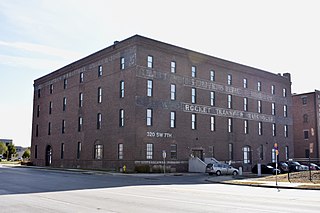
The Hawkeye Transfer Company Warehouse, also known as the Rocket Transfer Building, is a historic building located in downtown Des Moines, Iowa, United States. The building was built by Frederick Hubbell who founded F.M. Hubbell and Son, which became Hubbell Realty Co. The company has retained ownership of the building since it was built. Plans were approved in 2009 to convert the building, as well as the Schmitt and Henry Manufacturing Company complex, into loft apartments. It was listed on the National Register of Historic Places in 2010.

The Schmitt and Henry Manufacturing Company is a complex of three historic buildings located in downtown Des Moines, Iowa, United States. The complex was built in three stages from 1901 to 1914 by Schmitt-Henry, who manufactured furniture. It was designed by Des Moines architect Harry D. Rawson of the firm Proudfoot, Bird and Rawson. Sealy Mattress Company took over the building in 1973 after Schmitt-Henry moved to West Des Moines. Hubbell Reality purchased the complex in 1994 for $75.000. Plans were approved in 2009 to convert the complex, as well as the Hawkeye Transfer Company Warehouse, into loft apartments. It was listed on the National Register of Historic Places in 2010.
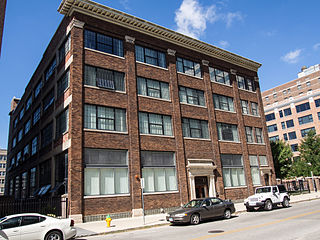
The Standard Glass and Paint Company Building, also known as 10th Street Lofts, is a historic building located in downtown Des Moines, Iowa, United States. Ashton and Ross Clemens, who were brothers, had the building built in 1913 to house their company, which was said to be the largest glass and paint business west of Chicago. Local contractor J.E. Lovejoy was responsible for its construction. It was one of several warehouse buildings on the southwest corner of the downtown area. Established by the Clemens brothers, Standard Glass and Paint Company was in existence from 1903 to 1979. It was Des Moines' leading wholesale and retail supplier of a variety of building and remodeling supplies. The company remained in this building until the mid-1920s when they moved to the Clemens Automobile Company Building, which was owned by the same family. After it sat empty until 1931 various wholesale companies occupied this building over the succeeding years. Along with the neighboring Herring Motor Car Company Building it has been converted into loft apartments. It was listed on the National Register of Historic Places in 2004.

The National Biscuit Company Building, also known as National Biscuit Company Flats, is a historic building located in downtown Des Moines, Iowa, United States. The heavy timber and masonry building was built in 1906. Only half of the planned building was completed, and the north half of the property was later sold. It initially served as a production and distribution facility for the National Biscuit Company. Architect William F. Wilmouth, who designed the company's buildings is presumed to be the architect of this four-story Neoclassical building. Benson & Marxer served as the contractors. Des Moines was the third largest sales territory for the company. It was one of a few bakeries in the company that produced the Uneeda Biscuit, and it was one of three that produced a corn cracker in the mid-1920s.

The Rumely–Des Moines Drug Company Building at 110 SW. Fourth St. in Des Moines, Iowa is a large brick warehouse block building. It is a work of architects Hallett & Rawson. It has also been known as the Rumely Bldg, as the Federal Machine Corp Bldg, and as the Security File Warehouse Building. It was listed on the National Register of Historic Places in 1989.
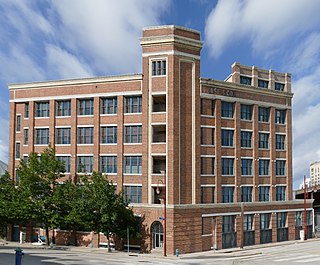
The National Biscuit Company Building, located at 15 North Chenevert in Houston, Texas, was built for Nabisco in 1910, and listed on the National Register of Historic Places on February 20, 1998. The structure was converted to apartments and is now known as City View Lofts.
The Eisenhower Bridge is located east of Milton, Iowa, United States. It carries traffic on 252nd Street over the Fox River for 197 feet (60 m). The supervisors from Des Moines and Lee counties met on September 7, 1887, to view the location of a new bridge between the two counties over the Skunk River on the Burlington-Fort Madison Road. Financing delayed building the new bridge. They determined that Des Moines County would pay three-fifths of the costs and Lee County the remainder. Chicago engineer Horace B. Horton designed the Pratt truss, and it was built by the James B. Diver Bridge Company of Keokuk, Iowa. The Walker's Ferry Bridge was originally a two-span structure, and it was completed for $9,435. It was replaced with another bridge in 1930, and one of the spans was relocated to this location. Known locally as the Eisenhower Bridge, it replaced an 1895 span that was washed out in a flood. While it lost some of its historical integrity, it remains an example of early wagon bridge construction. It is also one of the few iron truss bridges remaining in Iowa, and it was designed by a prominent bridge engineer. The bridge was listed on the National Register of Historic Places in 1998.

The Hamilton Brothers Building, also known as Warfield-Pratt & Howell Co. Wholesale Grocers, and the Hach Brothers Company, is a historic building located in Cedar Rapids, Iowa, United States. This is the only extant building associated with local businessman and politician John Taylor Hamilton. He was a representative of Cyrus McCormick at the time his company was opening new markets for his mechanical reaper and other implements. Hamilton expanded his business to other implement manufactures and included product lines for urban dwellers as well. His business grew beyond the local area to include the entire state. Built as a warehouse in 1899, it is the only building of this type left near the central business district. It is also the largest building of this type in the city. The four-story, brick, Romanesque Revival structure features large round arch openings on the main floor and smaller windows on the upper floors. It was listed on the National Register of Historic Places in 1994.
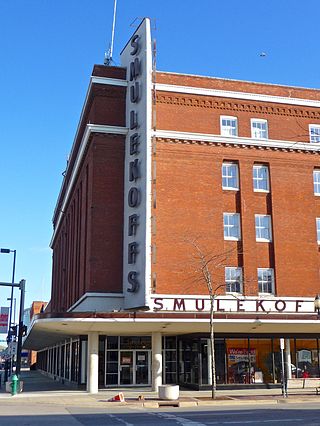
Smulekoffs Furniture Store, also known as the Sinclair Building, New Sinclair Building, Warfield–Pratt–Howell Co. building and the Churchill Drug Co. building, is a historic building located in Cedar Rapids, Iowa, United States. In 1901 Thomas Sinclair had the original section of this five-story brick structure built. It housed the wholesale grocer Warfield–Pratt–Howell Co. and another wholesaler, the Churchill Drug Co. It was the second of several large-scale warehouse buildings that were constructed in this section of the city along the Cedar River. A spur line of the Chicago, Milwaukee, St. Paul and Pacific Railroad was located at the rear of the building. Rosenbaum Furniture Store bought the building in 1925, and it was converted from warehouse use to retail. In 1941 Smulekoffs Furniture Store took over the building and renovated the main floor. They remained here until 2014. The building is slated for apartments on the upper floors and retail on the main floor. It was listed on the National Register of Historic Places in 2016.

The Henshie-Briggs Row House is a historic building located in Des Moines, Iowa, United States. While the row house was a popular building form in the 19th century in the city, there are very few examples that remain. The two-story, brick, Italianate structure was completed in 1883. The single-family dwelling features brick load-bearing walls, a flat roof, and a wooden cornice. The house was listed on the National Register of Historic Places in 2001. It was moved to its current location on Woodland Avenue in 2008.
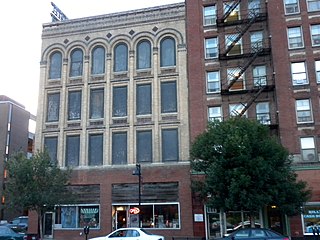
The Earle & LeBosquet Block, also known as the Redhead & Wellslager Block, is a historic building located in Des Moines, Iowa, United States. Completed in 1896, the building is a fine example of the work of Des Moines architect Charles E. Eastman. It shows Eastman's ability to use Neoclassical forms and integrate the more modern Chicago Commercial style. It is also an early use of terra cotta for architectural detailing and buff-colored brick for the main facade in Des Moines, which became widespread in the city in the following decades. The main floor housed two commercial spaces and the upper floors were used for warehouse space. The four-story structure was built by local contractor Gerrit Van Ginkel, and it was owned by attorneys Ira M. Earle and Peter S. LeBosquet. It replaced a three-story brick building that was built at this location in 1876. The building was listed on the National Register of Historic Places in 2009.
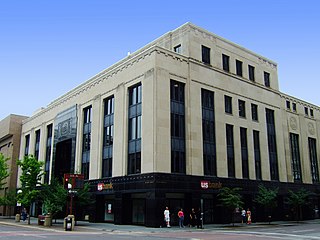
The Iowa-Des Moines National Bank Building, also known as the Valley National Bank Building and U.S. Bank, is a historic building located in downtown Des Moines, Iowa, United States. Designed by the prominent Des Moines architectural firm of Proudfoot, Rawson, Souers & Thomas, it was designed to be a 21- or 22-story building. It is one of the few downtown commercial buildings built in the Art Deco style. It is also thought to be one of the first bank buildings to put the banking room on the second floor while placing retail space on the first floor. Given its location in an area dominated by retail this made sense. This location had a bank on it since 1882 when the Des Moines National Bank built here. The present building was the result when Des Moines National Bank merged with Iowa National Bank and Des Moines Savings Bank and Trust Company in 1929. The original design for the building was a five-story base and a set-back rental office tower on top of it. The base was begun in 1931 and completed a year later. The building is composed of black polished granite on the first floor and the upper floors are Bedford stone. There is a recessed entrance in the center bay of the main facade. The fifth floor was meant to be the base of the office tower that was never built.

The Grocers Wholesale Company Building, also known as the Sears and Roebuck Farm Store, is a historic building located in Des Moines, Iowa, United States. Completed in 1916, this was the first of four warehouses built and owned by Iowa's only and most successful statewide cooperative grocery warehouse. It is possible that it was the first statewide organization of this kind in the country. The cooperative allowed independent grocers to compete against chain stores and survive wholesale grocers' surcharges. They leased their first warehouse after they organized in 1912. Each successive time the cooperative built a new warehouse it was larger and technologically more advanced than the previous one. This particular cooperative grew to include parts of four states: Iowa, southern Minnesota, northern Missouri and eastern Nebraska. They built their second warehouse in 1930 and moved out of this facility. They continued to own this building until 1968, and they leased it out to other firms. The Sears Farm Equipment Store began to occupy the building in 1937 and continued here until 1959. The cooperative became the Associated Grocers of Iowa in the late 1950s, and it continued in existence until 1985. The building was listed on the National Register of Historic Places in 2008.

The Taft–West Warehouse, also known as the C.C. Taft Company Building, Plumb Supply Company, Ben's Furniture Warehouse, and Nacho Mamma's, is a historic building located in Des Moines, Iowa, United States. Completed in 1923, this three-story brick structure was built during a transitional period between the dominance of railroads the emergence of trucks servicing warehouses. It was designed by local architectural firm of Vorse, Kraetsch, & Kraetsch. It features cleans lines of the Commercial style as opposed to the fussiness of late Victorian styling that was dominant in a great deal of the city's commercial architecture. The building was also located in the Court Avenue wholesale district, and now it is only one of only five or six that remain extant. The building was constructed for the C.C. Taft Company. This firm and the O.B. West Company that succeeded it in this building, dealt in wholesale fruits, vegetables, candy and tobacco. The building was listed on the National Register of Historic Places in 2006.

The Studebaker Corporation Branch Office Building, also known as the Iowa Truck and Tractor Co., Apperson Iowa Motor Car Co., Sears Auto Co., and the Sanders Motor Co., is a historic building located in Des Moines, Iowa, United States. This is actually two adjacent buildings, built four years apart. The building at 1442 Locust Street was completed in 1918 to house a Studebaker dealership, auto repair shop, and a corporate branch office. The addition of the corporate office made this building different from the others on Des Moines' "Auto Row," where it is located. The building was designed by the prominent local architectural firm of Proudfoot, Bird & Rawson, and built for the Hubbell Building Company who leased it out. The first floor was the location for Glass & Patton, the local Studebaker dealer. The second floor was where Studebaker's wholesale business in the state of Iowa was conducted. The third floor was a store room for automobiles. Studebaker's tenure here was short-lived, and by 1919 other auto and truck related businesses started to occupy the building.

The L. Harbach and Sons Furniture Warehouse and Factory Complex, also known as the Way-Helms Co. & Red Cross Mattress, L. Ginsberg & Sons wholesale furniture warehouse, and the A.A. Schneiderhahn electronic appliances warehouse, is a historic building located in Des Moines, Iowa, United States. This is actually two adjacent buildings completed in 1906. Their significance is their successive ownership by three prominent furniture retailers/wholesalers. L. Harbach & Sons Co. was one of Iowa's largest furniture wholesalers, and they manufactured furniture in Des Moines for more than seventy years. The company was established in 1856 by Louis Harbach, Sr. Louis had immigrated from Germany in 1850 at the age of 12. A catalog of their furniture is available at the National Museum of America. L. Harbach & Sons occupied this complex from 1906 to 1928. One of the buildings was their factory and the other was their warehouse. The Harbach family sold the business around 1920 to the Davidson family, who continued to use the Harbach name until through 1928, and continued to own the building until 1952. They leased the buildings to Way-Helms Co. & Red Cross Mattress for a short time, and then beginning in 1930, to the Ginsberg family. Both the Davidsons and the Ginsbergs owned local furniture stores. The Ginsbergs acquired the buildings from the Davisons and they owned them until 1985. They altered the building as trucks replaced trains as the main mode of transportation for furniture warehousing and distribution. The buildings were listed on the National Register of Historic Places in 2015.
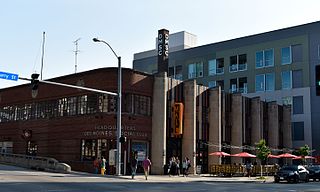
The Des Moines Fire Department Headquarters' Fire Station No. 1 and Shop Building are historic buildings located in downtown Des Moines, Iowa, United States. Completed in 1937, the facility provided a unified campus for the fire department's administration, citywide dispatch, training, maintenance, as well as the increased need for fire protective services in the commercial and warehouse districts in which the complex is located. It was designed by the Des Moines architectural firm of Proudfoot, Rawson, Brooks and Borg, and built by local contractor F.B. Dickinson & Co. The project provided jobs for local residents during the Great Depression, and 45% of its funding was provided by the Public Works Administration (PWA). The City of Des Moines provided the rest of the funds. The radio tower, which shares the historic designation with the building, was used to dispatch fire personnel from 1958 to 1978. The buildings were used by the local fire department from 1937 to 2013. It was replaced by two different facilities. The old fire station and shop building was acquired by the Des Moines Social Club, a nonprofit arts organization.

The Iowa Ford Tractor Company Repair and Warehouse Building is a historic building located in Des Moines, Iowa, United States. The single-story, 15,000-square-foot (1,400 m2) building was built in 1949. It was used by the Iowa Ford Tractor Company as a tractor repair and storage facility. In 1977 the building was acquired by the H.B. Leiserowitz Company. They were mostly a photography supply company but they were also a general store and they sold wholesale candy, soda, chips, and cigarettes to small grocery stories and gas stations. It closed in 2017 after its owner died. Green Acre Development Company bought the building later the same year and has plans to convert it into offices. It was listed on the National Register of Historic Places in 2021.






















